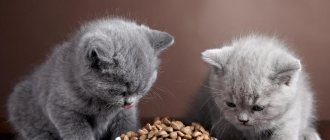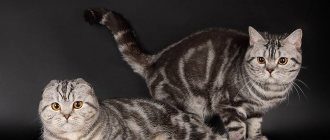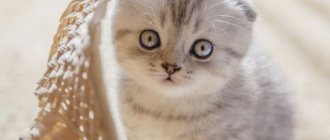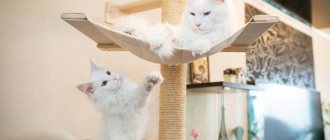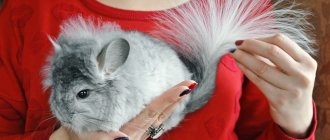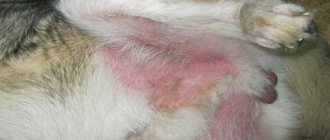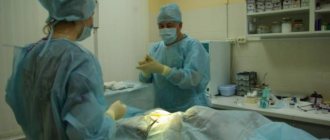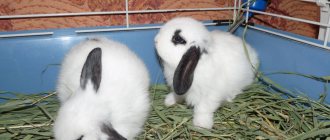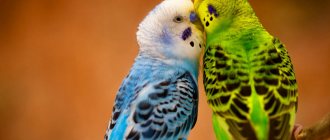How to care for a kitten at home
The formation of the body, health and life expectancy of an adult cat depend on proper care in the early period of life.
The formation of the body depends on proper care in the early period of life
Caring for newborn kittens
If the babies are with a cat, then the mother takes care of the offspring and the owner has few worries.
Need to control:
- "Nest" state. Clean the litter from wool and dirt.
- Weight gain. Newborns weigh approximately 120 g and, with normal development, gain 100 g weekly. Kittens grow a little faster than female cats. If the baby is growing more slowly, then he needs to be shown to the veterinarian.
- Condition of fur, eyes and ears. The coat should be dry and clean, and there should be no discharge from the ears and eyes. The cat's mother licks her offspring and healthy babies are always clean.
On the 8th day, the eyes open, by the end of the second week the babies begin to hear, and on the 20-21st day the kitten tries to walk.
There is no need to worry about newborns: the babies eat and sleep, actively gaining weight.
As soon as the baby opens its eyes, stands on its paws and begins to show interest in the world around it , the kitten needs to be picked up and stroked. Positive human contact will help the animal grow up affectionate and playful.
Care at 1 month
At this age, it is better not to take the baby away from its mother.
As soon as the baby opens his eyes, stands on his paws and begins to show interest in the world around him.
But if for some reason a month-old kitten is alone, then it will require special care:
- Feeding. The main diet should be milk. It is better to purchase a cat milk substitute at the veterinary store or dilute the dry milk by adding a little honey or sugar. Complementary foods (meat, porridge) are added in small doses. New food should be given in small quantities so as not to cause intestinal upset. You need to feed 6 times a day.
- Providing peristalsis. The cat licks the baby's tummy, stimulating intestinal function. To help the pet, the owner needs to moisten a cotton pad with warm water and massage first the sides and then the tummy in a circular motion from the sternum to the groin.
- Fresh water. If food is given on a schedule, then water should be in the bowl at all times.
Be sure to read:
Reasons and ways to suppress a cat’s aggression and calm the animal down if it gets angry, meows, cries before bedtime
The animal must be toilet trained immediately. If the kitten begins to worry and “look for a place,” then you need to take it and put it in the tray.
You need to be persistent if the baby tries to run away and refuses to “do his business” in the designated area. The procedure must be carried out several times until the small pet understands where to defecate.
If your pet refuses to go to the litter box, then perhaps he is frightened by the large granules of the filler or does not like the consistency. By changing the toilet filling, you will be able to cope with the problem.
At this age, you should begin to accustom long-haired kittens to brushing. It is better to purchase a soft brush that detangles the fur and does not scratch the skin: then the combing procedure will be perceived as a pleasure by your pet.
Kitten without a cat is clean
Good mother cats always keep their babies clean. While they are feeding them milk, you don’t even notice when they go to the toilet, and you don’t know that at first kittens cannot do it on their own. Therefore, when caring for a kitten up to 3 weeks without a cat, you will need to help him with this. After the next feeding, wipe his bottom with a cotton pad soaked in warm water. This will stimulate his bladder and bowels.
Then lay him on his back, wipe his tummy and butt in one direction. He should start urinating. When caring for a kitten that has reached 2 weeks of age without a cat, monitor the color of the stool. If the urine smells and turns dark, the kittens are dehydrated. It should be pale yellow and odorless.
As you know, cats are very clean animals. Therefore, you cannot do without daily washing when caring for a kitten up to 1 month without a cat. Soak a soft piece of material in warm water and wipe the fur. Then walk over with a dry towel and you can send your baby to bed.
An indicator of proper development is regular weight gain. It should grow exponentially. When caring for a kitten without a cat, it doubles within 1 week after birth. Weigh yourself regularly. They should add about 30g per day.
If you get past the most difficult period, then you will not need to explain how to care for a month-old kitten without a cat. An older pet does not require much attention. Monitor the calorie content of your food and start teaching your fidget to go to the litter box.
Whether a four-legged pet with a pedigree was purchased from a breeder, born from a domestic cat, or picked up on the street - any baby needs care and attention.
In order for an obedient and healthy animal to grow up, you need to know how to feed, raise, how to care for a kitten, taking into account its age, and how to arrange a cat corner.
How to care for kittens without a cat
It is better to purchase a cat's milk substitute.
It happens that the mother dies during childbirth, and the owner is left with blind, squeaking offspring.
The owner will have to replace the kittens' mother:
- Heating. A heating pad with water heated to a temperature of 35°C, on which a soft mattress is laid, works well. It is not recommended to place newborns near heating devices or warm them with an infrared lamp. In the first case, this will cause overheating, and the use of lamps may affect vision when babies open their eyes.
- Feeding. It is better to buy a cat's milk substitute, but if this is not possible, you can use cow's milk, adding a pinch of sugar. It is important not to feed formulas with a high percentage of fat in the first weeks. To give food, use a bottle with a nipple or feed with a pipette. Dishes are washed and sterilized after each meal. Feeding is carried out at intervals of 2-2.5 hours.
- Hygiene. To maintain cleanliness, the baby's fur must be wiped with a damp cloth. Bathing at an early age is prohibited. The ears are cleaned from accumulations of wax with a cotton swab, and to care for opened eyes, it is recommended to take an eye wash from a veterinary pharmacy.
- Stimulates digestion. After each meal, massage your tummy and sides in a circular motion from the chest to the perineum.
Be sure to read:
Which mat cutter is best for cats: straight, curved, how to use it, how much it costs
By the third week, kittens will begin to walk. In addition to feeding and care, you will need to pay attention to education: toilet training, showing a scratching post.
Kittens grow quickly and what is developed in the first days and weeks of life will become the basis for the behavior of an adult animal.
The most important point is feeding
Proper nutrition is the key to your pet's health. Pay special attention to this moment.
When feeding naturally you should avoid:
- river fish and bones;
- white cabbage and legumes;
- lard and pork;
- pearl barley, corn and millet;
- mushrooms and potatoes;
- sorrel, onion and garlic;
- raisins and grapes;
- any products from the human table.
With dry food everything is much simpler. Here it is important to focus on the standards specified by the manufacturer, not to buy low-quality brands and choose age-appropriate lines. Please note that you will have to adhere to the chosen type of nutrition throughout your life.
Feeding a newborn without a mother
Newborns are fed special formulas, the composition of which is close to cat milk. Cheaper options (goat's and cow's milk) are fraught with vitamin deficiency and intestinal disorders in babies.
Prepare for sleepless nights. For the first 2 weeks, the cat will have to be fed every 2-3 hours, that is, approximately 7-8 times a day. A night break (no more than 5 hours) can be introduced only in the 3rd week. It is better to check the daily dose with a veterinarian, since it is very easy to overload a child’s stomach.
Feeding at 1 month: introduction of complementary foods
At 3-4 weeks, the first milk teeth appear, so caring for a 1-month-old kitten differs from caring for a newborn. From this moment on, the first complementary foods can be introduced into the diet. All food served must be boiled and crushed to a puree-like consistency.
The baby is fed 6-7 times a day in small portions of 17 g. In addition to milk, the menu includes boiled yolks, minced meat, milk porridge from semolina and rice, low-fat fermented milk products and vegetable puree.
Feeding from 2 to 4 months
Caring for a kitten for 2 months is supplemented by the inclusion of solid food. Well-frozen and boiled meat and fish are cut into small pieces, replacing minced meat with them. The daily portion is increased to 150 g, and the number of feedings is reduced to 5.
From 3 months, when calculating portions, the weight of the animal is taken into account, as the body enters a phase of rapid growth. For every kg of weight there should be 200 g of food, and the frequency of feeding should be reduced to 4 times.
The amount of fermented milk products is reduced in favor of meat and raw vegetables. It is also recommended to give up milk and reduce the amount of water used when cooking porridge.
Feeding from 5 to 7 months
Puberty often occurs during this period. Pets of different sexes living under the same roof mature before anyone else.
The regime is gradually being brought closer to that of an adult, so that the eight-month-old cat no longer eats 4 times, but 2 or 3. The portion also increases, since the weight does not stand still. This indicator should be monitored very carefully, since undersupply and excess are equally harmful to health.
Feeding a grown pet
Older cats are fed twice a day, but the veterinarian may make some changes to this routine. Make sure your pet gets enough protein, fat and carbohydrates. The ideal percentage ratio of these elements is 52:36:12.
The majority of the diet should consist of proteins of meat origin, that is, meat, fish and offal. The menu also needs to include vitamins and minerals that cannot be replenished with regular food.
Choosing a place for a kitten's toilet
Cats try to satisfy their natural needs in an intimate environment, and the place chosen for the toilet in the apartment must meet a number of requirements:
- Availability. The kitten should be able to go to the litter box at any time.
- Privacy. Animals do not like to be looked at while they are emptying their bowels or bladder.
- Comfort. If the baby does not like the litter, then it is almost impossible to force him to go to the tray. It is recommended to take the pellets that were used by the breeder.
Familiar filler and a comfortable environment will allow the kitten to quickly get used to the new place.
Kitten nutrition
How to care for a kitten
It is better to feed the baby on time, with even intervals between meals:
- up to 2 months – 5 times;
- by the age of six months, the frequency of feedings gradually decreases to 3 times, and the portion gradually increases;
- An eight-month-old animal is fed like an adult - twice a day.
Your pet's diet must include:
- raw beef;
- boiled chicken meat;
- milk porridge;
- egg yolk;
- raw and boiled vegetables;
- fermented milk products.
You cannot feed food from the human table: salt and spices are harmful to the cat’s body.
Be sure to read:
How to wash a cat's eyes at home: pharmacy and folk remedies, when required
Veterinarians recommend purchasing balanced cat food for kittens, taking into account age. Specialized mixtures contain all the necessary elements necessary for the growth of a pet.
Caring for a one-month-old kitten
Caring for a small pet has a number of important nuances. You should not wash your kitten until it is 2 months old, as it may catch a cold due to temperature changes. However, you need to constantly monitor the cleanliness of his eyes, fur and mouth.
All discharge from the eyes should be removed using cotton swabs with extreme care. They are also used when cleaning an animal’s ears.
Trim claws
At an early stage of a pet’s life, it is already necessary to accustom it to such a procedure as trimming its claws. To do this, first the kitten must get used to pressing the paw pads. Then they use a special tool - a nail clipper. It can be bought at any pet store. Before each use, nail clippers must be disinfected to avoid infection.
Clean the kitten
The animal's fur should be cleaned regularly and using a non-standard method, because bathing the kitten is still prohibited. First, wipe all the wool with a clean damp cloth, then do the same with a dry towel. Such procedures are carried out every time after the kitten eats or goes to the toilet.
Teeth cleaning
Fluffy pets have their teeth brushed much less often than people - about once every 5-7 days. To do this, use a special item - a toothbrush for kittens. It is different from the usual one and is better suited for animals. Along with it, you need to buy cat toothpaste at the pet store.
Combing out the wool
Short-haired breeds do not require careful brushing. On average, this procedure will have to be carried out 1-2 times a week. For long-haired pets, grooming (care for the appearance of animals aimed at cleaning the surface of the body) should be done every day using special brushes.
Proper hair care involves observing certain points:
- Before the procedure, the kitten must get used to the brush.
- The main principle of care is accuracy.
- During grooming, the cat should be rewarded for calm behavior.
- You need to start cleaning from the back and sides, only then move on to the stomach and paws.
- Each subsequent procedure should be longer than the previous one.
Toys and other things for development and communication with a kitten
All children love to play, and felines are no exception. Having settled in a new place, the baby begins to enjoy running after a piece of paper on a string or chasing various objects across the floor.
It is better to make sure that the kitten has its own things:
- Movable toys. Fur balls, rubber mice and other similar things. It is important that toys do not have small parts: kittens are teething, the baby can bite off a small part and choke.
- Hanging objects. A ball hanging on a thread on the door handle will occupy the attention of a cat child for a long time.
- Scratching post. Sharpening claws is a natural need of the cat tribe. If you do not acquire this useful item, the furniture or carpet will suffer. In the first days, you need to show your pet a place where it is allowed to sharpen its claws.
A good option would be to purchase a special complex where your pet can climb and jump.
In addition to the fact that the device develops the cat's dexterity and flexibility, purchasing a device will reduce the likelihood that a playful baby will throw flowers from the windowsill or objects from the table.
Necessary things
Before the cat appears in the house, it is necessary to purchase personal belongings for it. This will make life easier not only for the pet, but also for people.
cat litter
Kittens living in an apartment need a tray. Even if the pet runs outside, it is necessary to accustom it to the tray. There are situations when the owners of the animal are late at work or leave home for 1-2 days, but the kitten will be able to relieve itself in the appropriate place.
There is no need to worry about a puddle or an unpleasant-smelling pile appearing in the house. The pet will do all its business in the tray, the main thing is to teach it this in a timely manner. Trays come in various types:
- closed (European structures);
- open;
- open with bars.
The first option looks aesthetically pleasing, but requires financial investment. The design itself costs a pretty penny, and the filler required is expensive - silica gel or gel. This type of toilet takes up a lot of space, so it is suitable for apartments with a large layout.
There are also more economical options. For example, a tray with or without a grid. A tray without a grid is convenient because filler does not spill out over its high sides. The lattice design allows you to save on filler, but requires constant maintenance.
It is advisable to immediately purchase a large tray. Kittens grow quickly, and the small litter box will have to be replaced with a larger one. You should not worry that the kitten will not climb over the high sides. Curiosity and good jumping ability will help the animal at first.
Many pet owners dream of having their pet relieve itself on a shared toilet. You can get used to this too. There are special toilet pads on sale that allow you to teach your kitten to use the toilet.
This has a huge advantage: you don’t have to spend money on a tray and filler for it, the toilet will not have the cat smell and dirt that appears when using wood or bentonite filler.
Filler and its types
Each animal has its own preferences. Some pets enjoy going into the sawdust, others need sand, and some just need a clean tray. Fillers make life much easier for cat owners; they absorb moisture and absorb unpleasant odors. There are several types of cat litter:
- Locking ones are considered the most profitable in terms of saving money and time on cleaning the toilet. The filler is poured into the tray in large quantities. The animal's urine flows to the very bottom of the tray, where it is absorbed by the bottom layer of filler. The filler is replaced if the top layer changes color and begins to emit an unpleasant odor.
- Clumping litter – dissolves under the influence of your pet’s urine, forming lumps. They must be removed from the tray as they form.
- Absorbent fillers are made from waste from the woodworking industry. They are cheaper than other types, but require high consumption and frequent replacement.
Necessary equipment for feeding
Your pet will need several bowls. Preferably glass, not cheap plastic ones. No one controls the quality of plastic used to make dishes for animals. Glass does not absorb odors, is easy to clean and is considered safer for health.
There must be at least 3 bowls.
One should always be in the feeding area. It is filled with clean drinking water. The other two are used for dry and wet food.
Devices for combing wool
Animals, like people, need to be brushed. This allows you to remove dead hair and also massage your baby's skin. Regular brushing makes the kitten's coat well-groomed and shiny.
To care for the animal, special combs are purchased. Plastic combs electrify wool and are therefore not recommended for use. Combs for people are also not suitable. Special metal brushes with sparse teeth are produced for cats. A more convenient option is products that fit on your hand.
The use of slicker brushes is justified before participating in exhibitions. The rest of the time it is better not to use them. They damage the fur, so the kitten's appearance may deteriorate.
scratching post
Kittens do a daily warm-up, and the set of exercises includes sharpening their claws. To prevent a pet that appears in the house from ruining the furniture, it is necessary to familiarize it with the scratching post from the very first days of its stay. A special pole covered with hemp or sisal thread will replace the tree that wild cats are used to sharpening their claws on.
A little trick will help you accustom your baby to daily exercise. The threads on the post are treated with a solution of catnip (catnip). The smell attracts the pet, and he happily sharpens his claws on the scratching post, and not on a leather corner in the kitchen or a luxurious sofa in the living room (read more about how to train a kitten to use a scratching post).
You can purchase a scratching post at any pet store or build it yourself. It won't take much time, but it will save you money.
Toys
The baby really misses his mother, so he tries to entertain himself with any things that fall under his furry paws. To prevent the kitten from stealing threads, rings, bottle caps, buttons and other small things, you need to take care of the toys. You can buy a fur mouse, a soft foam ball, or tie a candy wrapper to a thread. Any toys will do.
Carrying bag
For trips to the veterinarian or to the countryside, you will need a special bag. Various options are available:
- plastic baskets with bars;
- fabric bags with mesh (insulated with foam rubber, lightweight, made of lightweight waterproof material).
You need to decide for what purpose you need the carrier. For traveling on a plane or train, the best option is a cage-basket. If the kitten will travel only by car, it is better to choose a soft bag.
Many kittens love to sleep in a house; a carrier bag can become a temporary resting place for the baby. It should be placed in a safe place, and a soft mat should be laid on the bottom.
Repellent and habituation sprays
It is very difficult to convince a kitten that the rug in the hallway is not a good place for a toilet. If your baby is constantly misbehaving, sprays will come to the rescue. Repellent compounds will prevent the kitten from visiting forbidden places.
But to accustom him to a carrier, tray or scratching post, you will need attractive sprays. The kitten likes their smell, and he is interested in the fragrant object. Sprays do not harm animals or humans, so they are used without fear.
Mouth care products
Tartar deposits and dental problems occur in cats due to the fact that the owners have not taught kittens to brush their teeth since childhood. It is necessary to start the procedure from a very early age of the pet. It is unlikely that an adult, untrained cat will be able to brush his teeth.
Special toothbrushes that fit on your finger and meat-flavored toothpaste that does not require rinsing will make the procedure painless and beneficial. There are 2 types of toothbrushes for cats:
- massage;
- bristly.
Veterinarians recommend purchasing both types and changing them periodically to improve the quality of teeth cleaning and massage the gums.
If attempts at hygienic brushing of teeth fail, instead of a toothbrush and toothpaste, you can use a special liquid composition designed to clean the surface of the teeth from food. The liquid is odorless and tasteless, so the cat drinks it instead of water. It is enough to take a teaspoon of the product and dilute it in a bowl of water (250 ml). The cat always drinks water after eating, so dental care will be regular.
